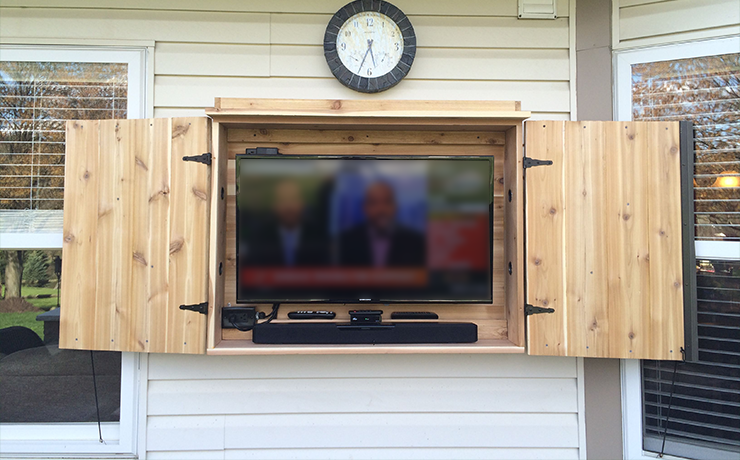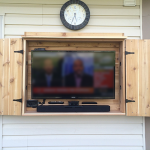
How an Outdoor Entertainment System Boosts Home Value
Outdoor entertainment is more than a nice extra. It changes how a home is used, day to night, weekday to weekend. When buyers tour a property and see a real setup—an outdoor TV with a clear picture and weather protection, and speakers that make music feel close by—they picture hosting friends, kids’ movie nights, or a quiet game after work. That picture sticks. While kitchens and baths matter, a simple, sturdy outdoor system signals “move-in ready fun.” This blog explains how outdoor TVs and outdoor speakers can boost home value. We’ll cover what matters, what to buy, and easy setup wins that make listings stand out without adding noise or risk. Simple steps lead to real results.
Why Outdoor Entertainment Raises Buyer Interest
Home shoppers react to spaces they can use right away. A deck with a true entertainment system looks finished, not like a project. That reduces their mental to-do list and can help your home stand out in photos and at showings. Outdoor TVs and speakers also widen the ways a yard is used—sports watch parties, family movies, or background music for dinner. This added use often translates into stronger offers because buyers see more value in the same square footage.
Key reasons it helps:
- Instant use: No need to plan, shop, or wire later.
- Lifestyle appeal: Sports, movies, and music outside feel special.
- Perceived upgrade: Weatherproof gear looks like a premium add-on.
- Low upkeep: Modern outdoor gear is built to handle sun and rain.
When the setup looks clean and safe, it suggests the rest of the home is cared for as well.
Outdoor Tv Basics That Truly Matter
Not all screens are ready for the backyard. Outdoor TVs are built with sealed cases, venting that resists moisture, and parts rated for heat, cold, and dust. The rating you want to look for is IP (Ingress Protection). A common level for outdoor enclosures is IP55, which means the unit is protected against limited dust and water jets from any direction. Some models use anti-corrosion coatings on boards and stainless steel screws to avoid rust. These details protect your investment and reduce future repair costs.
Important specs in plain terms:
- Weather rating: Look for IP ratings and UV-resistant cases.
- Operating range: Check temperature range (for example, −20°C to 50°C).
- Brightness: Measured in nits. Outdoor sets often start at 700+ nits.
- Glare control: Anti-reflective glass helps in sunlight.
- Inputs: HDMI 2.0/2.1 for modern sources; eARC for audio return.
- Mounting: Use outdoor-rated mounts with stainless hardware.
These features are easy for a buyer to spot in a showing and will make your listing notes stronger.
Bright, Clear Pictures In Real Daylight
The hardest part of outdoor viewing is light. Regular indoor TVs often peak around 300–400 nits. Outside, it can look dim and washed out. An outdoor TV with 700–1500 nits fights daylight without blowing out colors. Anti-glare coatings and a matte panel reduce reflections from the sky and walls. Placement helps too: a shaded wall, an overhang, or a tilting mount can cut glare by a lot.
Practical tips:
- Aim for shade: Under a pergola or eave keeps the screen readable.
- Use tilt/swivel mounts: Turn the screen away from the sun or windows.
- Mind viewing angles: VA panels have deeper contrast; IPS keeps color consistent off-axis.
- Source quality: Stream in HD/4K; use strong Wi-Fi or a wired run to avoid buffering.
- Cable runs: Use outdoor-rated HDMI or conduit for protection.
When buyers see a bright, easy-to-watch screen—even at noon—they understand the setup is real and useful.
Outdoor Speakers That Sound Full And Clear
Great sound makes the space feel finished. Outdoor speakers come in wall-mount, rock-style, and in-ground/subwoofer options. They use weather-resistant cones, sealed crossovers, and tough grills. Many are rated 8 ohms, which works with most home amps. For large areas, 70-volt (70V) speaker systems let you run longer cable runs and add more speakers with simple taps, common in patios and gardens.
What to look for:
- Materials: Poly cones, rubber surrounds, powder-coated grills.
- Coverage: More small speakers at low volume beat two loud ones.
- Frequency range: A hidden outdoor sub (in-ground or under-bench) adds bass without shaking fences.
- Power handling: Match speaker watts to your amp’s output.
- Impedance planning: Keep the total load safe for the amp (avoid going below rated ohms).
Sound layout basics:
- Zoning: Split areas (dining, fire pit, pool) so you can set different volumes.
- Even spacing: Keeps music smooth as you walk, so guests aren’t stuck near a loud spot.
- Cable choice: Use direct-burial rated cable for runs in soil.
A smooth, even sound field feels calm and high-quality, which buyers notice.
Smart Control, Wiring, And Reliable Connections
A neat system is easier to use and looks better in listing photos. Keep the brain of the system—streaming box, amp, and surge protection—inside a small media cabinet or weather-rated box. Many setups use a multichannel amplifier or a streaming amp that handles Wi-Fi, Bluetooth, and app control. For stable streaming, a wired Ethernet line to the TV or amp is best; if that’s not possible, add a mesh Wi-Fi node near the patio.
Helpful technical notes:
- ARC/eARC: One HDMI cable can send TV audio back to the amp.
- CEC control: Lets a single remote power TV and sources together.
- PoE options: Some small streamers or access points can run on Power over Ethernet.
- Surge protection: Use outdoor-rated surge protectors and GFCI outlets.
- Conduit: UV-rated conduit protects cables from the sun and pets.
- Labeling: Label each cable and zone for easy tweaks later.
Simple control lowers user error. Buyers like seeing a system they can run without a manual.
Safety, Weather Care, And Small Maintenance Steps
Safety adds confidence. Outdoor outlets near the TV and amp should be GFCI-protected. Use drip loops on cables so water runs off instead of into ports. Mount TVs with lag bolts set into studs or solid masonry anchors. For speakers, stainless hardware prevents rust streaks on walls. To protect from storms, some homeowners add locking covers for remotes and a soft TV cover when not in use.
Easy maintenance checklist:
- Quarterly wipe-down: Use a soft cloth on the screen and grills.
- Check seals: Make sure gaskets and port plugs are snug.
- Tighten mounts: Quick turn on bolts stops long-term sag.
- Vent space: Leave breathing room around amps for heat.
- Seasonal test: Play a test track and a test video to confirm all zones work.
These steps cost little and make the setup last longer, which reduces risk for a buyer.
Budget Ranges, Simple Wins, And Likely ROI
You don’t need a stadium built to make an impact. A clean, mid-range setup often brings the best return because it looks finished without being flashy. While the exact return varies by market, agents often report stronger traffic and faster offers when a yard shows clear uses and neat upgrades.
Typical ranges (actual prices vary by brand and size):
- Outdoor TV: 55–65″ models with 700–1000 nits are common picks.
- Mount and cover: Outdoor-rated mount and soft cover for downtime.
- Speakers: Two to six wall-mount speakers, plus an outdoor sub if the area is large.
- Amp/streamer: One streaming amp can run multiple zones.
- Cabling and hardware: Direct-burial wire, conduit, stainless screws.
Quick wins that boost appeal:
- Mount the TV at eye level when seated.
- Use a tidy cable path with clips or conduit.
- Add a small dimmable light near the screen.
- Pre-save “Movie Night,” “Game Day,” and “Dinner” scenes in the app.
These touches make photos pop and help buyers picture daily use.
Upgrade Ideas For Different Yard Sizes
Every yard can host a simple, strong setup if planned well:
Small patio or balcony
- 43–55″ outdoor TV on a swing arm mount
- Two compact outdoor speakers on the wall
- Single streaming amp in the living room cabinet
- One mesh Wi-Fi node near the patio door
Mid-size deck
- 55–65″ outdoor TV under eave
- Four speakers spaced evenly; optional slim sub under bench
- Two zones (dining and lounge) on one amp with app control
- Ethernet line in conduit from router to TV area
Large yard or pool
- 65–75″ outdoor TV in a shaded area
- Six to eight 70V speakers across the yard for even sound
- In-ground sub near lounge zone for gentle low end
- Central rack with surge protection, labeled zones, and a simple wall keypad
Matching the plan to the space keeps sound even and the screen viewable, which shows care and adds value.
Conclusion and Next Steps For Homeowners
An outdoor TV and a clean speaker layout can turn a plain yard into a daily living area. Buyers see more ways to use the home, and that often helps the sale. Focus on weather-rated gear, bright screens, even sound, neat wiring, and safe power. Keep control simple so anyone can press play. If you want help, Becker Media Design installs outdoor systems—from outdoor TV installation to outdoor speakers—and sets them up the right way. We make sure the parts fit your space, sound smooth, and look tidy. A few smart choices now can make your home more fun to use and more attractive to future buyers.







